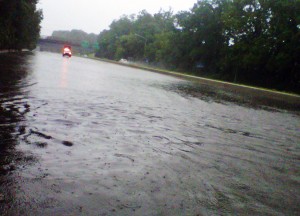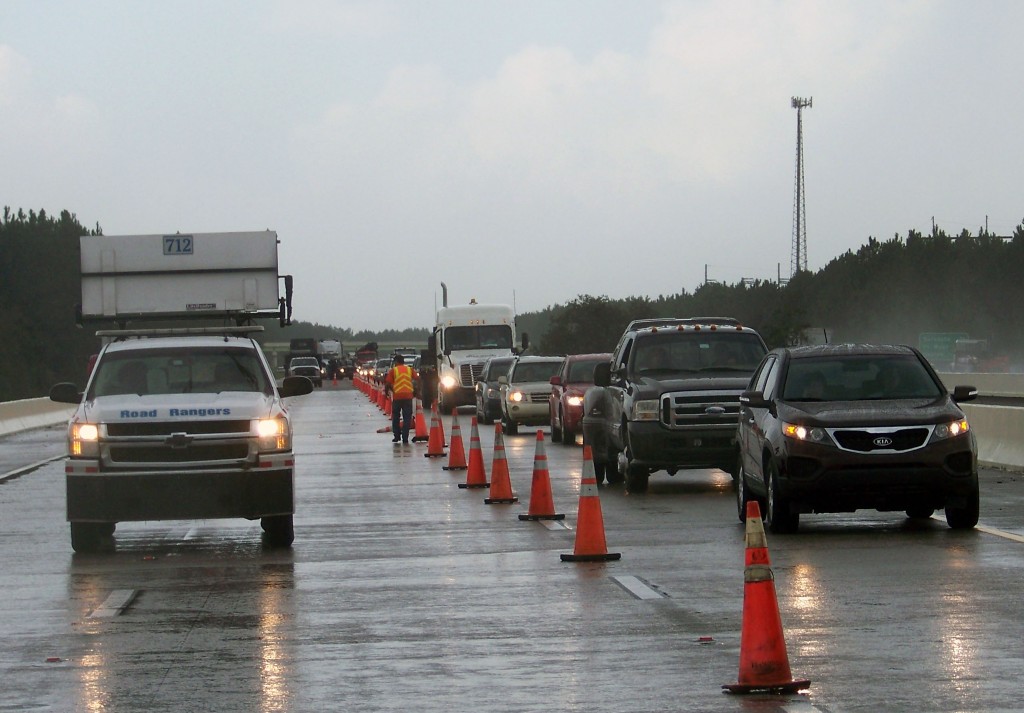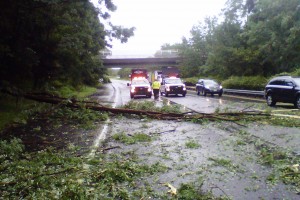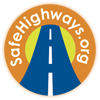Weathering the Storm
How Safety Service Patrols Prepare for and Respond to Natural Disasters
By Sarah Stanley
In New Jersey the northern winters frequently bring strong winds and blizzards, but the proximity of its communities to the coastline also opens the state to the impact of large hurricanes as evidenced this past October when Superstorm Sandy hit the Jersey Shore. In comparison, states like Florida, North Carolina and Louisiana are less likely to be hit by a massive snowstorm and more likely to be the target of a destructive hurricane or tropical storm. These state transportation departments’ Safety Service Patrol (SSP) programs have response plans in place to address storm-related emergency situations quickly and appropriately to ensure the safety of the public traveling the roadways. SSP contingency plans typically include extended patrol hours, expanded coverage areas, special equipment and interagency communications.
Extended Patrol Hours
Upon the declaration of a state of emergency, departments of transportation move quickly to increase both SSP service hours and manpower before, during and after the storm. Operating hours are usually extended and more patrol vehicles and operators are pressed into service to provide greater response capacity for the duration of a storm. The Florida Department of Transportation’s (FDOT) Road Ranger contractors, for example, are alerted that additional crews may be needed to operate the entire SSP fleet. During evacuations, FDOT adjusts Road Rangers’ schedules and can extend patrol hours as needed.
The Louisiana Department of Transportation and Development (LADOTD) Motorist Assistant Patrol’s (MAP) extends their 14/7 schedule to a 24/7 schedule during emergencies. If the need is present, LADOTD adds additional service trucks by requesting MAP contractors to pull from their existing fleets. The supplementary tow trucks, sign trucks, striping trucks and pickups receive temporary MAP markings and work on the same emergency-based 24-hour schedule as the MAP vehicles. Emergency vehicle drivers operate these additional trucks and provide basic services, allowing MAP operators to focus more on extraordinary tasks.

State departments of transportation increase SSP manpower and extend patrol coverage hours during natural disasters. Photo credit Gabriel Maged, NJDOT.
As part of the New Jersey Department of Transportation’s (NJDOT) emergency response plan, Safety Service Patrol crews move from a two 8 hour shift schedule to a two 12 hour shift schedule (noon-midnight and midnight-noon). No driver, no matter their enthusiasm, is allowed to work more than four hours before or after their twelve hour shift in an effort to prevent fatigue-related incidents. This extension continues until an “all clear” is received from the command post.
The patrols are not, however, expected to work during a storm’s peak. The NJDOT calls in and releases SSP drivers from duty in order to avoid their getting “stuck” in the storm’s pathway. In Louisiana, “the stand-down phase,” when crews are called off the road, takes effect six hours prior to landfall in Louisiana or when winds reach tropical storm strength, whichever occurs first. During the storm, “trucks are staged in district locations and maintenance lots,” says Stephen Glascock, Intelligent Transportation Systems Director at LADOTD. “Our folks will shelter in place until the storm passes and then will return to the roadway.”
High winds can cause the suspension of the Florida Department of Transportation’s (FDOT) Road Ranger service. “Road Rangers are on the front lines, so they can provide accurate, real-time descriptions of traffic volumes and patterns,” says Patrick Odom, FDOT Traffic Incident Management and Road Ranger Manager. However, “we want to make sure the Road Rangers are safe and can return to the road after the hazardous situation passes.” So when sustained winds reach tropical storm strength the service is suspended and once conditions are safe, the Road Rangers will return to their patrols. Even without the patrol’s eyes, FDOT can still monitor critical road segments via its hundreds of closed-circuit television (CCTV) cameras. These cameras are shared publicly on the state’s 511 website so that local and regional partner agencies can also see what is happening.
Expanded Coverage Areas
Natural disasters do not always impact an SSP’s standard patrol coverage area. Departments of transportation reassign patrols to major arteries in the areas affected by a storm. In New Jersey, after the SSP reopens the normally covered 225 miles of state highways, the patrol drivers assist crews on other parts of the interstate. In regard to reopening the roads after a disaster, “we go as a strike team,” explains Dennis Motiani, NJDOT Executive Director of Transportation Systems Management.
The North Carolina Department of Transportation (NCDOT) responds to severe weather events on a case-by-case basis, reallocating its resources to address areas in need. If a storm is approaching, the Incident Management Patrol (IMAP) gears up around the coastal areas. Typically, the patrol covers major interstates west of I-95, 2-3 hours inland from the coastal areas.
As soon as the NCDOT IMAP trucks are relocated to cover the evacuation areas, patrol drivers report to the State Traffic Operations Center, rather than the regional one, to streamline communications. Routes are often smaller, more focused, and slower moving during a natural disaster. Meredith McDiarmid, State Systems Operations Engineer for the North Carolina Department of Transportation (NCDOT) Traffic Systems Operations Unit, finds motorists requiring assistance have a greater need for maintenance (e.g. tire changes, overheating, etc.). “In major evacuations when we would anticipate extreme volumes of evacuees, we may stage a gas truck in strategic places to allow our IMAP drivers to quickly refuel their containers,” explains McDiarmid.

Safety Service Patrols often cover new areas and roadways during natural disasters, especially evacuation routes.
The FDOT Road Rangers continue to perform their standard traffic incident management responsibilities even in the event of an evacuation, but they focus on getting people to a safe area. A few are prepped for in-field supply delivery and others may be assigned to locations outside of their normal patrol. For example, three major bridges in Tampa, which are critical to coastal evacuations, are staffed by Road Rangers despite the bridges not being a part of the standard patrol coverage areas. If necessary, trucks can be sent out of district. “Contracts are written so that Road Rangers can be sent anywhere in the state,” says Terry Hensley, FDOT District Seven Road Ranger Project Manager. “The key to our program is that we are very flexible. If the Road Ranger is trained, equipped, and available, I’ll send them to do the job.” The Road Rangers’ radios work on the Statewide Law Enforcement Radio System (SLERS) channel so “in theory, they should be able to relocate and still communicate by radio.” This connection also directly connects them to law enforcement.
North Carolina DOT also directs their efforts on evacuees. “If there is a mandatory – or even voluntary – evacuation we have the Incident Management Patrol (IMAP) go to those established routes and help keep people moving.” McDiarmid stresses, “Territorial walls drop during crisis.”
The LADOTD MAP works around the clock and has expanded to up to 150 miles of coverage in the New Orleans region, three times the size of its normal service area, during a natural disaster. During Hurricane Isaac, MAP even covered some local streets to provide traffic control at food distribution points. Isaac caused so much flooding that some interstate travel lanes had to be closed. Typically, the state police man these types of closures, but to free the state police up for other tasks, MAP drivers were assigned to the posts. LADOTD’s Glascock reflects with pride: “One of the biggest things that the patrols have done is transform our agency. The program has expanded its scope from assisting motorists – which they still do – to being a first responder.
Special Equipment
During natural disaster response, the patrols’ tasks change as do some of the tools and equipment. The FDOT Road Ranger trucks are provisioned with extra water and back-up batteries for their phones and radios. NJDOT SSP increases regular equipment supplies to include additional fuel supply, protective gear, and towing straps and hooks. NJDOT finds that by providing extra protective gear, such as gloves or goggles, patrol drivers can focus more on the response effort rather than become distracted if a glove or goggle is blown across the road by high winds. In addition, providing extra towing straps has proven effective when more than one strap is needed to effectively tow a disabled vehicle to a safe location.

Safety Service Patrols are provided with new and additional equipment and supplies to improve storm response efforts. Photo credit Gabriel Maged, NJDOT.
Due to the many added distractions on the road, the NJDOT SSP uses red and amber lighting to increase visibility. Particularly at night, the use of SSP lights make work zones safer. Some SSP trucks are fitted with plows to push large debris and chainsaws to cut fallen trees, while others are assigned to patrolling, providing aid to stranded motorists. To clear the road of unusual debris left in the storm’s aftermath that is too large to be easily carried, LADOTD MAP uses rope or cable to tow it to the side of the road.
Interagency Communications
Since natural disasters know no political boundaries, interagency communications are a critically important component to state contingency plans. Open communication among states through organizations like the Transportation Operations Coordinating Committee (TRANSCOM), an organization that facilitates interagency communications among sixteen transportation and public safety agencies in the New York, New Jersey and Connecticut metropolitan areas, and the I-95 Corridor Coalition, which brings together sixteen participating states from Maine to Florida, improves response efforts.
“The I-95 Corridor Coalition is a volunteer, consensus driven organization that works with the member states to accomplish more together than can be accomplished as individual states,” says Tom Martin, Operations Program Coordinator for I-95 Corridor Coalition. The I-95 Corridor Coalition aims to provide a forum for states to address best practices for responding to large-scale events and natural disasters for Safety Service Patrols and other participating emergency response agencies.
While not all states have the same program protocol, the core functions are consistent. “There is such a blend within the 16 states of how [response to natural disasters] is handled,” explains Martin. “I would not recommend one best way – it’s what works best for each state.” Three areas the Coalition does recommend remain consistent across states are: 1) attention to safety, 2) the importance of complying with each agency’s own policies, and 3) after-action reports and meetings to identify successes and lessons learned.
As a post-disaster practice, the NJDOT hosts regular meetings with state police and collects feedback from supervisors in order to continuously improve its response plan. The NJDOT uses its base emergency response plan (for snow), which is reviewed every year prior to the regular snow (and freezing) season, as a starting point for crafting a disaster specific plan. Immediately upon notice of an impending major weather event, the NJDOT adjusts its approach appropriately and customizes its plan with information collected through team calls with TRANSCOM and other partner agencies. “Normally these storms have some advance notice so between conference calls and operations meetings, a plan of action is identified,” says NJDOT’s Motiani.
Eventually, whether the process takes days, weeks, months or in the case of Louisiana after Hurricane Katrina and New Jersey after Hurricane Sandy the coverage areas and surrounding communities recover from the destruction caused by one storm and still must prepare for the next. LADOTD conducts after-action reviews that involve DOT, MAP contractors, state police and other agencies, while NCDOT addresses all recent natural disasters at quarterly meetings. As a means of preparation, each spring, many FDOT districts participate in a hurricane exercise with other state departments, utilizing the opportunity to ensure they have their local contacts and resources in place before the next big storm.
In the wake of high impact storms in recent years and the certainty of more natural disasters in the future, state departments of transportation and toll road authorities are taking measures to improve their preparedness and response to natural disasters. First responders are charged with some of the most difficult and dangerous tasks during these emergency situations and are often recognized as the heroes of local communities. Through continued interagency communications, the sharing of best practices and performance evaluations, Safety Service Patrols will continue to be an invaluable asset to natural disaster response teams.
